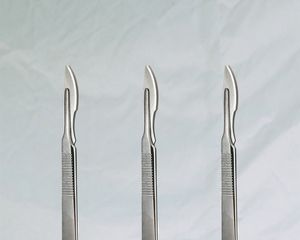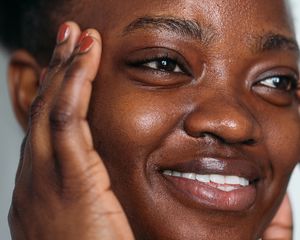
Getty / Design by Cristina Cianci
These days, it can feel like nose jobs are a dime a dozen—they simply don’t carry the same stigma they did back in, say, Heidi Montag’s day. And yet most plastic surgeons agree that it is still one of the most challenging cosmetic plastic surgery procedures.
Most obviously, the nose is in the middle of one’s face. Plus, simultaneous nasal deformity correction and preservation of maximal nasal function is no simple feat. So it follows that while a nose job is considered a very safe procedure, there’s high risk of a poor outcome. But what happens when a patient’s goals, cosmetic or functional, aren’t met via rhinoplasty? One of several potential options is revision rhinoplasty.
We spoke with plastic surgeons Robert Sigal, MD, and Ritu Chopra, MS, MD, about revision rhinoplasty. Read on for everything you need to know about the sniffer stitch-up.
Meet the Expert
- Robert Sigal, MD, is president of Austin-Weston, The Center for Cosmetic Surgery in Reston, Virginia.
- Ritu Chopra, MS, MD, is a plastic surgeon at the Plastic Surgery Institute in Beverly Hills and co-founder of Solvasa.
What Is a Revision Rhinoplasty?
According to Sigal, a revision rhinoplasty is exactly what it sounds like—a second rhinoplasty surgery (more commonly known as a nose job) meant to correct or revise a previous surgery that didn’t work out to the patient’s satisfaction.
“The nose is a gentle balance of form and function, and those two factors are sometimes in competition with each other,” explains Chopra. “Patient communication is imperative.”
A poor rhinoplasty outcome might mean cosmetic failure (the nose looking different than desired or even worse than pre-procedure) or functional failure (compromised nasal airflow or internal disruption). Sigal also notes that a revision rhinoplasty can take many forms, some of which are really quite easy to fix, meanwhile others that are incredibly complex.
It’s important to recognize that plastic surgeons aren’t always to blame for unsuccessful rhinoplasty. Outside factors are always in play.
Given that cartilage has a memory of sorts, there’s always a risk that a nose shifts back to its original shape over time. Another non-surgeon-related issue is external valve collapse, in which a collapse of the tip cartilages results in nasal obstruction post-op. The nose has incredibly complicated anatomy. Fault aside, a revision rhinoplasty can be a great opportunity to correct lingering issues, depending on your goals.
Both doctors say that realistic goal-setting is perhaps the most important factor in a revision rhinoplasty.
According to Chopra, the success of the procedure really lies in the sensibility of the patient. If someone is looking to jump surgeons soon after initial surgery, that impatience speaks to her. “Besides the fact that it’s too early to judge, it’s a warning sign that this patient is not listening to sage advice and reason.”
Sigal agrees, telling me that being a good candidate, and, in turn, having a successful outcome, “lies inside the patient’s head almost as much as it lies outside the patient’s nose.”
On a more surface level, ideal candidates should be at least one to two years post-op in order to be absolutely sure that the issue isn’t due to swelling or simply temporary.
And, of course, it’s important to note that all the risks of rhinoplasty are equally, if not more, possible with a revision rhinoplasty. Patients might experience new scarring, worsening of the prior condition, or a lack of resolution of the condition they were hoping to fix. Both doctors stress that patients need to be aware of these potential risks prior to surgery.
Benefits of a Revision Rhinoplasty
Unfortunately, there are no guarantees of clinical outcomes when it comes to revision rhinoplasty. Both doctors say that patients should seriously consider benefits and risks, and make their decisions accordingly. While you can never guarantee that a revision rhinoplasty will fix all issues, the general goals and benefits if all goes according to plan, are:
- Corrected nasal deformities: Revision rhinoplasty procedures can correct deformities caused by lacking structure or medical complications.
- Maximal nasal function: A pretty nose is useless if it doesn’t work well. Maximizing nasal function is often the most important benefit of revision rhinoplasty. Compromised function could come from a past nose job or could be natural and missed or ignored during that first surgery.
- Improved appearance: It can be disheartening when, after thousands of dollars and a long recovery, your nose job doesn’t look the way you wanted it to. For many, revision rhinoplasty can be an opportunity to get closer to your cosmetic goal.
Sigal notes that a successful rhinoplasty quiets our own inner critic, at least about our nose. If an initial rhinoplasty is unsuccessful in making that voice go away, and if the surgeon is experienced and thinks the patient and his or her nose is appropriate, sometimes a second surgery can do the trick.
The most important thing to remember is that perfection is not attainable—it’s simply unrealistic. A revision rhinoplasty isn’t about improving upon an already successful surgery. It’s corrective, which also means that original desired outcomes might not be possible due to problems with previous rhinoplasty procedures. Managing expectations is key.
“Secondary rhinoplasties can be harder than primary rhinoplasties,” Sigal explains. “A good candidate for any rhinoplasty should ‘have a nose’ and not ‘be their nose.’ If your identity is so tied up in your nose that ‘perfect’ is the only possible end result, you were never a good candidate for rhinoplasty in the first place and should think long and hard before a secondary procedure.”
How to Prepare for a Revision Rhinoplasty
Sigal and Chopra are in complete agreement about revision rhinoplasty preparations: Be sure the goals and expectations of the procedure are crystal clear to both the patient and the surgeon.
“It should be broken down into a choreographed menu of actions for the surgeon,” explains Chopra. “Do the bones need to be narrower? The tip raised? The nostrils moved in? And so on. The surgeon's job is to extract these things, but the patient needs to assist in that understanding.”
Surgeons should be reputable and have ample experience not only in rhinoplasty but in revision rhinoplasty as well.
“If a doctor says he doesn’t think he can help, don’t go to another surgeon who will tell you what you want to hear,” warns Sigal. “You will always find someone who, for whatever reason, will tell you what you want to hear.”
What to Expect During a Revision Rhinoplasty
For the patient, a revision rhinoplasty is much the same as the original surgery.
For surgeons, almost all revision rhinoplasties use the same method, says Sigal. It begins with what’s called an “open” approach, where a small cut across the columella (which, in layperson’s speak, is the bridge of tissue separating the nostrils at the bridge of the nose). This allows for better visualization of the underlying structures of the nose.
Then, the procedure tends to go one of two ways. Either the first rhinoplasty left things “underdone,” and a secondary takedown of either bone or cartilage is needed. Or, the nose has been overcorrected and tissue needs to be added back. While the tissue is relatively easy to procure—it can come from the patient, a cadaver, or even a box—added tissue adds the complexity of graft healing to an already complicated and somewhat unpredictable healing process.
Potential Side Effects
There’s a reason revision rhinoplasty is so difficult. “The tissues are no longer ‘normal,’” Sigal says. “Scar tissue has replaced it. Because of this, usual and customary maneuvers made during rhinoplasty can have unintended consequences. If these consequences are extreme, unfixable disfigurement can result.”
Chopra agrees, explaining that there are a lot of unknowns until the surgery is actually underway.
“What exactly did the previous surgeon leave us with? Is patient scar tissue part of the problem or part of the solution?” she says. “Plus, blood flow to the tissue is reduced and healing to completion may take longer.”
Like with regular rhinoplasty surgeries, other risks include difficult breathing, changes in skin sensation, infection, poor wound healing or scarring, skin discoloration and swelling, and unsatisfactory nasal appearance.
The Cost
Cost is heavily dependent on what needs to be done. A full surgery probably costs somewhere around $10,000. Meanwhile if the problem can be fixed with filler, it’ll likely be closer to a few hundred dollars.
“It’s a broad range based upon the time in surgery and the ‘problem list,’” Chopra notes. “In general, because it’s more difficult, it’s a bit more than the original surgery. If the original surgeon was selected because of a low price, remember the old adage: You get what you pay for.”
Aftercare
Like cost, aftercare is very much dependent on what actually happens. If a little bit of filler handles the problem, you can go out to dinner that night. If a surgery is needed, aftercare becomes more complex.
As with most nasal operations, healing to completion is a long journey, but people are often fairly functional after a week. Patients should plan to take a minimum of a one-month break from all sports.
On a lighter note, Chopra says that the swelling from a revision surgery is often not noticed at all, since it mimics the problem that necessitated the revision in the first place.
The Final Takeaway
Whether or not one needs a revision rhinoplasty isn’t straightforward. It bears repeating, given the precarious results and possible risks: A patient’s state of mind is just as important as a patient’s state of nose.
Both doctors emphasize the importance of really hearing a doctor out in terms of what is and isn’t feasible, and having realistic expectations. After all, surgery results are never guaranteed.
That being said, if a patient is unhappy with the results of their initial rhinoplasty, and a reputable surgeon is on board and in agreement, a revision rhinoplasty is an opportunity to finally arrive at the results they were looking for in the first place.

















